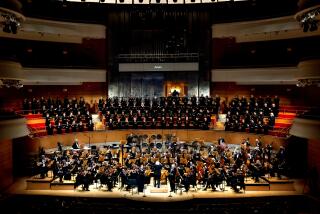Music Reviews : Scottish Chamber Orchestra at El Camino
The Scottish Chamber Orchestra opened a weekend series of concerts in the area Friday at El Camino College with a curiously--but apparently characteristically--bifocal program. Standard-brand chamber-band offerings partnered pieces by conductor Peter Maxwell Davies, in a state of separate but equal grace.
Daviesâ Oboe Concerto, a.k.a. âStrathclyde Concerto No. 1,â and âAn Orkney Wedding, With Sunrise,â were heard just this summer at the Ojai Festival, also with the composer conducting. Both works merit rehearing, the concerto for its convoluted, brooding bravura, âAn Orkney Weddingâ for its outgoing energy.
The concerto is a considerable challenge for listeners, because Daviesâ rhetoric loses urgency through the course of three much subdivided movements. It is thus a challenge to the soloist to pull it together in the face of formidable technical obstacles.
Robin Miller, principal oboist of the orchestra, sustained the windy discourse with clear musical intelligence. Register breaks are readily exposed--almost tauntingly--by the wide-ranging demands, but Miller projected steady confidence and a sure sense of direction throughout.
âAn Orkney Weddingâ is a brightly colored, thoroughly evocative tone-poem, originally composed for the Boston Pops centennial. Davies and Co.--the vital solo contributions capably headed by concertmaster John Doig and piper Neil Johnstone--treated it with brash, well-practiced affection.
The conventional portion of the program featured Cecile Licad as the protagonist in Beethovenâs Piano Concerto No. 1. There was little conventional about her interpretation, however, which exuded personality at every turn, bolstered by comprehensive technique.
At times, Licadâs playing revealed the defects of its virtues: Character could lapse into exaggeration, strength could produce hard, grainy sound. But the virtues remained freshest in memory, particularly as displayed in her moody, Chopinesque account of the Andante.
Davies, working throughout without a baton, kept the accompaniment supportive. In the opener, Mozartâs Symphony No. 39, K.543, he seemed content with a sort of genial, general purpose bounce, laying out the symphony in agreeable if undistinctive terms.
More to Read
The biggest entertainment stories
Get our big stories about Hollywood, film, television, music, arts, culture and more right in your inbox as soon as they publish.
You may occasionally receive promotional content from the Los Angeles Times.










